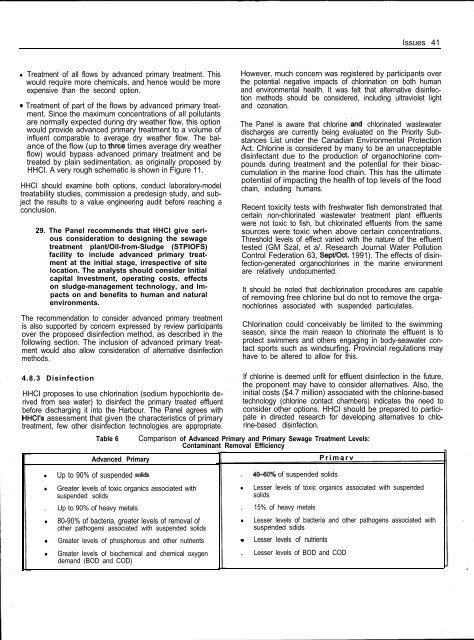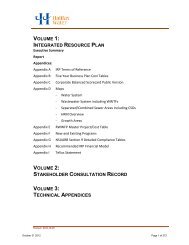Halifax Harbour Cleanup Inc. - Halifax Regional Municipality
Halifax Harbour Cleanup Inc. - Halifax Regional Municipality
Halifax Harbour Cleanup Inc. - Halifax Regional Municipality
You also want an ePaper? Increase the reach of your titles
YUMPU automatically turns print PDFs into web optimized ePapers that Google loves.
Issues 41<br />
• Treatment of all flows by advanced primary treatment. This<br />
would require more chemicals, and hence would be more<br />
expensive than the second option.<br />
0 Treatment of part of the flows by advanced primary treatment.<br />
Since the maximum concentrations of all pollutants<br />
are normally expected during dry weather flow, this option<br />
would provide advanced primary treatment to a volume of<br />
influent comparable to average dry weather flow. The balance<br />
of the flow (up to three times average dry weather<br />
flow) would bypass advanced primary treatment and be<br />
treated by plain sedimentation, as originally proposed by<br />
HHCI. A very rough schematic is shown in Figure 11.<br />
HHCI should examine both options, conduct laboratory-model<br />
treatability studies, commission a predesign study, and subject<br />
the results to a value engineering audit before reaching a<br />
conclusion.<br />
29. The Panel recommends that HHCI give serious<br />
consideration to designing the sewage<br />
treatment plant/Oil-from-Sludge (STPIOFS)<br />
facility to include advanced primary treatment<br />
at the initial stage, irrespective of site<br />
location. The analysts should consider Initial<br />
capital Investment, operating costs, effects<br />
on sludge-management technology, and lmpacts<br />
on and benefits to human and natural<br />
environments.<br />
The recommendation to consider advanced primary treatment<br />
is also supported by concern expressed by review participants<br />
over the proposed disinfection method, as described in the<br />
following section. The inclusion of advanced primary treatment<br />
would also allow consideration of alternative disinfection<br />
methods.<br />
However, much concern was registered by participants over<br />
the potential negative impacts of chlorination on both human<br />
and environmental health. It was felt that alternative disinfection<br />
methods should be considered, including ultraviolet light<br />
and ozonation.<br />
The Panel is aware that chlorine and chlorinated wastewater<br />
discharges are currently being evaluated on the Priority Substances<br />
List under the Canadian Environmental Protection<br />
Act. Chlorine is considered by many to be an unacceptable<br />
disinfectant due to the production of organochlorine compounds<br />
during treatment and the potential for their bioaccumulation<br />
in the marine food chain. This has the ultimate<br />
potential of impacting the health of top levels of the food<br />
chain, including humans.<br />
Recent toxicity tests with freshwater fish demonstrated that<br />
certain non-chlorinated wastewater treatment plant effluents<br />
were not toxic to fish, but chlorinated effluents from the same<br />
sources were toxic when above certain concentrations.<br />
Threshold levels of effect varied with the nature of the effluent<br />
tested (GM Szal, et a/. Research Journal Water Pollution<br />
Control Federation 63, SeptIOct. 1991). The effects of disinfection-generated<br />
organochlorines in the marine environment<br />
are relatively undocumented.<br />
It should be noted that dechlorination procedures are capable<br />
of removing free chlorine but do not to remove the organochlorines<br />
associated with suspended particulates.<br />
Chlorination could conceivably be limited to the swimming<br />
season, since the main reason to chlorinate the effluent is to<br />
protect swimmers and others engaging in body-seawater contact<br />
sports such as windsurfing. Provincial regulations may<br />
have to be altered to allow for this.<br />
4.8.3 Disinfection<br />
HHCI proposes to use chlorination (sodium hypochlorite derived<br />
from sea water) to disinfect the primary treated effluent<br />
before discharging it into the <strong>Harbour</strong>. The Panel agrees with<br />
HHCl’s assessment that given the characteristics of primary<br />
treatment, few other disinfection technologies are appropriate.<br />
Table 6<br />
Advanced Primary<br />
If chlorine is deemed unfit for effluent disinfection in the future,<br />
the proponent may have to consider alternatives. Also, the<br />
initial costs ($4.7 million) associated with the chlorine-based<br />
technology (chlorine contact chambers) indicates the need to<br />
consider other options. HHCI should be prepared to participate<br />
in directed research for developing alternatives to chlorine-based<br />
disinfection.<br />
Comparison of Advanced Primary and Primary Sewage Treatment Levels:<br />
Contaminant Removal Efficiency<br />
Primarv<br />
• Up to 90% of suspended sotids<br />
• Greater levels of toxic organics associated with<br />
suspended solids<br />
. Up to 90% of heavy metals<br />
• 80-90% of bacteria, greater levels of removal of<br />
other pathogens associated with suspended solids<br />
• Greater levels of phosphorous and other nutrients<br />
• Greater levels of biochemical and chemical oxygen<br />
demand (BOD and COD)<br />
. 4&60% of suspended solids<br />
• Lesser levels of toxic organics associated with suspended<br />
solids<br />
. 15% of heavy metals<br />
• Lesser levels of bacteria and other pathogens associated with<br />
suspended sdids<br />
0 Lesser levels of nutrients<br />
. Lesser levels of BOD and COD

















